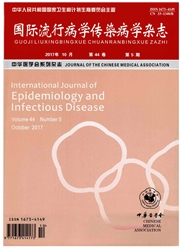

 中文摘要:
中文摘要:
目的 了解舟山市普陀区发热伴血小板减少综合征病毒的流行情况及分子生物学特征,为制订疾病预防控制措施提供科学依据.方法 采集普陀区六横岛和登步岛健康人群静脉血清各300份,用双抗原ELISA方法作抗体检测.检测3例实验室确诊患者的急性期静脉血清病毒核酸,阳性样本进行序列测定后做同源性比对和遗传进化分析.结果 健康人群血清抗体总阳性率3.5%(21/600),其中发病区与无疫情地区的抗体阳性率分别为6.0%和1.0%,两者差异具有统计学意义(χ^2=9.67,P<0.01).3例确诊病例血清中病毒L、M、S基因序列比对结果为99.8%~100.0%,与来源于岱山长途岛病毒基因序列具有高度同源性.结论 舟山普陀六横岛健康人群中发热伴血小板减少综合征病毒抗体阳性率明显高于登步岛.普陀六横岛的病毒遗传进化分析显示与本市岱山长途岛流行的病毒基因有高度同源性,与国内的江苏JS6、辽宁的LN3及宁波的也有较高的同源性,而与舟山市流行的优势病毒序列有一定的差异.
 英文摘要:
英文摘要:
Objective To explore the prevalence and molecular biological characteristics of severe fever with thrombocytopenia syndrome (SFTS) virus among different populations in Putuo District of Zhoushan and provide scientific basis for disease prevention and control.Methods There were 300 venous blood samples collected from healthy people in Liuheng Island and Dengbu Island,respectively,which were tested by a double antigen ELISA method for antibody detection.The serum viral RNA in 3 SFTS patients with acute phase was detected.After the positive samples were sequenced,the genes were investeaged through homology comparison and genetic evolution analysis,Results The total positive rate of serum antibody was 3.5% (21/600) in healthy people.The positive rates of antibody were 6% and 1% in epidemic area and pest free area,respectively,with statistically significant difference (χ^2 =9.67,P〈0.01).The viral L,M and S genes in 3 confirmed cases had high sequence similarity of 99.8%-100.0%,which were highly homologous to the gene sequence of the virus from Changtu Island in Daishan.Conclusions The positive rate of SFTS viral antibody in the healthy population of Liuheng Island is significantly higher than that of Dengbu Island.Viral genetic evolution shows that the viral gene from Lioheng Island is highly homologous to the Changtu Island in Daishan,and also has high homology with JS6 in Jiangsu,N3 in Liaoning,as well as SFTS virus from Ningbo.However,it has a certain difference with the dominant viral sequences in Zhoushan City.
 同期刊论文项目
同期刊论文项目
 同项目期刊论文
同项目期刊论文
 期刊信息
期刊信息
